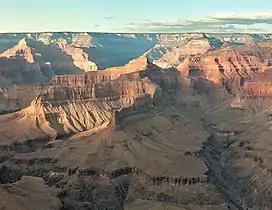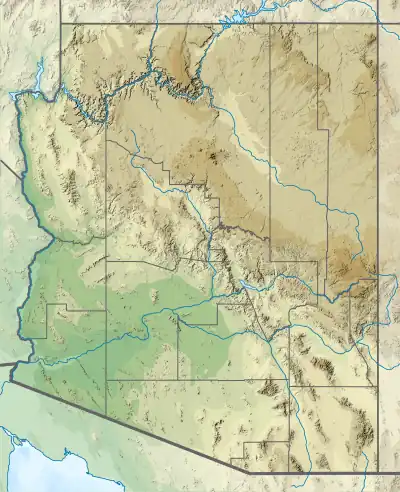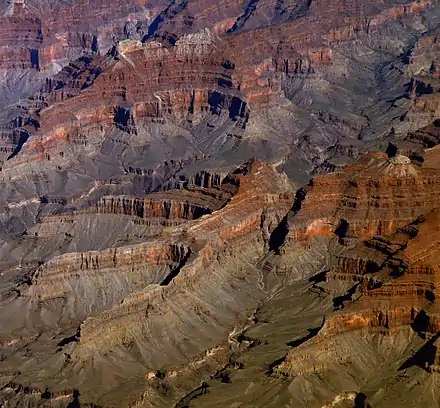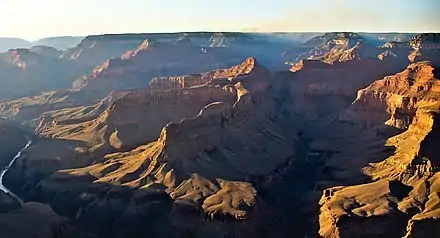Tower of Ra
Tower of Ra is a 6,129-foot-elevation (1,868-meter) pillar located in the Grand Canyon, in Coconino County of Arizona, US.[2] Its summit is situated five miles north of Pima Point overlook on the canyon's South Rim, three miles southeast of Confucius Temple, and two miles northwest of Tower of Set, where it towers over 3,700 feet (1,100 meters) above the Colorado River. Tower of Ra was named in 1879 by Thomas Moran, for Ra, the Egyptian deity of the sun.[2][3] This followed the naming convention of Clarence Dutton who began the tradition of naming geographical features in the Grand Canyon after mythological deities.[4] This mountain's name was officially adopted in 1906 by the U.S. Board on Geographic Names.[2] The first ascent was made in 1977 by Jim Haggart, Art Christiansen, and Barbara Zinn. According to the Köppen climate classification system, Tower of Ra is located in a cold semi-arid climate zone.[5]
| Tower of Ra | |
|---|---|
 South aspect, from Hermits Rest on South Rim | |
| Highest point | |
| Elevation | 6,129 ft (1,868 m)[1] |
| Prominence | 709 ft (216 m)[1] |
| Parent peak | Osiris Temple (6,613 ft)[1] |
| Isolation | 0.97 mi (1.56 km)[1] |
| Coordinates | 36°08′27″N 112°12′14″W[2] |
| Geography | |
 Tower of Ra Location in Arizona  Tower of Ra Tower of Ra (the United States) | |
| Location | Grand Canyon National Park Coconino County, Arizona, US |
| Parent range | Kaibab Plateau Colorado Plateau |
| Topo map | USGS Shiva Temple |
| Geology | |
| Type of rock | sandstone, siltstone, mudstone |
| Climbing | |
| First ascent | 1977 |
| Easiest route | class 5.1 climbing[1] |
Geology
The top of Tower of Ra is composed of the reddish Pennsylvanian-Permian Supai Group.[6] Further down are strata of Mississippian Redwall Limestone, the Cambrian Tonto Group, and finally granite of the Paleoproterozoic Vishnu Basement Rocks at river level. Precipitation runoff from Tower of Ra drains south to the Colorado River via Crystal and Ninetyfour Mile Creeks.
References
- "Tower of Ra – 6,129' AZ". Lists of John. Retrieved December 23, 2020.
- "Tower of Ra". Geographic Names Information System. United States Geological Survey, United States Department of the Interior. Retrieved 2020-12-23.
- Gregory McNamee, Grand Canyon Place Names, 1997, Mountaineers Publisher, ISBN 9780898865332, page 110.
- Randy Moore and Kara Felicia Witt, The Grand Canyon: An Encyclopedia of Geography, History, and Culture, 2018, ABC-CLIO Publisher, page 151.
- Peel, M. C.; Finlayson, B. L.; McMahon, T. A. (2007). "Updated world map of the Köppen−Geiger climate classification". Hydrol. Earth Syst. Sci. 11. ISSN 1027-5606.
- N.H. Darton, Story of the Grand Canyon of Arizona, 1917, page 37.

External links
- Weather forecast: National Weather Service
